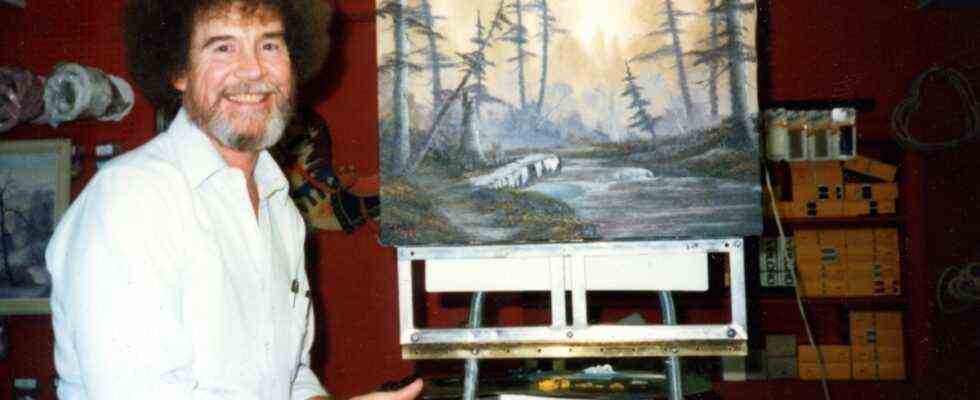One reason for the popularity of the TV painter Bob Ross was his soft voice – he always sounded on TV as if he was lying in bed with a woman.
This is what his former business partner Annette Kowalski says, and she might know what she’s talking about: She is said to have had an affair with Ross, even though both were married to other partners. Even after Ross’ early death – he died of lymph gland cancer in 1995 at the age of 52 – she is said to have expanded his estate against his will into a Bob Ross devotional shop.
With his name and face, with mugs and T-shirts, paints and brushes and supposedly original paintings, she makes millions of dollars every year to this day. And against the will of the deceased. At least that’s what his son says in the documentary “Bob Ross: Happy Accidents, Fraud & Greed”, which can be seen on Netflix. In it, the director Joshua Rofé tells from the son’s perspective of the bitter dispute over the legacy of the TV icon.
On his deathbed, the business partners tried to get him to surrender the rights to his name
Steve Ross, 55, appeared on “The Joy of Painting”, his father’s show, as a teenager. The series, which has 403 episodes in 31 seasons, was a hit not only in the US, but worldwide. To this day it runs on many channels in continuous nightly rotation. To this day, Ross’ son tours America and teaches landscape painting using the wet-on-wet technique that his father popularized among thousands of amateur painters who revere him like a guru. Bob Ross, enthusiastic disciples report in the film, saved her from deep depression and life crises with his painting courses, with motifs of trees and clouds and mountain lakes.
Ross’ favorite landscape motifs come from Alaska, where as a young man he was stationed as a sergeant at Eielson Air Force Base for many years. At that time, as photos in the film show, he was not yet wearing his legendary Afro, but a veritable Elvis great. He felt a passion for painting early on, and after he had finished his military career, he was determined to put painting at the center of his life.
First he made his way as an art teacher and representative for painting supplies along the east coast. His role model was the German exile and painter William “Bill” Alexander, who hosted the program “The Magic of Oil Painting” on the US broadcaster PBS. It was at this time that Bob Ross met the couple Annette and Walter Kowalski, and they both recognized his potential: Because the other TV painting teachers were mostly strictly didactic, they quickly realized that the friendly, cheerful, calm Ross would be a much better presenter would.
Bob Ross’ son Steve still teaches the wet-on-wet painting technique that his father was so enthusiastic about. Unfortunately, he has not received anything from his inheritance, he says.
(Photo: Netflix)
And Bob Ross, who wanted his little son from his first marriage and his second wife well looked after, was very keen on a career boost. He did not shy away from the public either, he liked to appear in front of an audience. Ross, his wife and the Kowalskis signed a contract in which they sealed as four equal business partners that they would make him a television star together. Which then, with minimal effort – black background curtain, an easel – led to great success.
In 1983 “The Joy of Painting” went on the air and became a hit. After a few years, the son and some of Ross’ companions suggest in interviews in the documentary, there were already differences of opinion about the future structure of the Bob Ross empire. While the artist himself would have preferred to concentrate on his painting courses and his broadcast, of which he often recorded three or more episodes per day, the Kowalskis had bigger things in mind. Bob Ross as a changing brand on as many licensed products as possible. The film portrays them as unscrupulous businessmen who aggressively attacked all competitors.
Which is why the news that Ross had cancer was said to have been bad economic news for her. The couple appears in the film only in archive recordings. They refused to participate in front of the camera and only denied in writing that Annette Kowalski had ever had an affair with Ross and that the rift had occurred shortly before his death. According to the filmmakers, a good dozen other people involved didn’t want to take part either – for fear of being sued by the Kowalskis, which is often the case.
When the father was dying, the son says, the Kowalskis asked him to wrest a signature from Ross in order to have all rights to his person transferred. “They want to steal my name on my deathbed,” cried Bob Ross in horror. The Kowalskis did not come to his funeral.
Why do they still hold the rights to his name to this day and are the bosses of the Bob Ross Incorporation? Will she actually sell pictures that Ross didn’t even paint as his? The filmmakers pursue these questions meticulously. The whole story is quite confused legally and in the end maybe not quite as scandalous as the film sometimes portrays it.
Nevertheless, the documentary is a beautiful portrait of the painter, whose face is known to everyone who has been unable to sleep at night and has switched on the television. And, of all things, the gentle Bob Ross liked to disregard every speed limit in real life with his Corvette, is also nice to find out.

